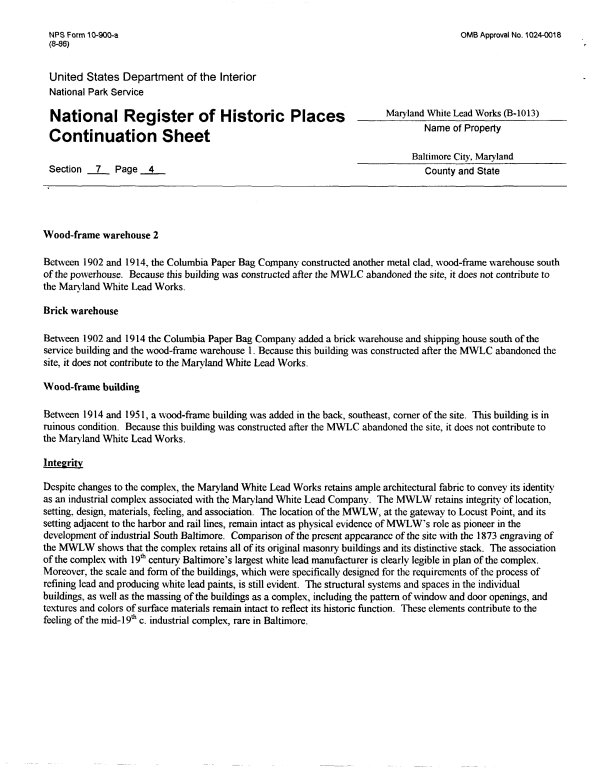 |
||||
|
DEPARTMENT OF HOUSING AND COMMUNITY DEVELOPMENT, MARYLAND HISTORICAL TRUST (Historic Sites Survey) var.d. MSA SE16-2 Image No: se16-2-0008 Enlarge and print image (57K) |
 |
||||
|
DEPARTMENT OF HOUSING AND COMMUNITY DEVELOPMENT, MARYLAND HISTORICAL TRUST (Historic Sites Survey) var.d. MSA SE16-2 Image No: se16-2-0008 Enlarge and print image (57K) |
| NFS Form 10-900-a OMB Approval No. 1024-0018 (8-86) United States Department of the Interior National Park Service National Register of Historic Places Maiyland whiteLeadWorks(B'1013) -* A. ,. —, A Name of Property Continuation Sheet Baltimore City, Maryland Section 7 Page 4 County and State Wood-frame warehouse 2 Between 1902 and 1914, the Columbia Paper Bag Company constructed another metal clad, wood-frame warehouse south of the powerhouse. Because this building was constructed after the MWLC abandoned the site, it does not contribute to the Man-land White Lead Works. Brick warehouse Between 1902 and 1914 the Columbia Paper Bag Company added a brick warehouse and shipping house south of the service building and the wood-frame warehouse 1. Because this building was constructed after the MWLC abandoned the site, it does not contribute to the Maryland White Lead Works. Wood-frame building Between 1914 and 1951, a wood-frame building was added in the back, southeast, corner of the site. This building is in ruinous condition. Because this building was constructed after the MWLC abandoned the site, it does not contribute to the Maryland White Lead Works. Integrity Despite changes to the complex, the Maryland White Lead Works retains ample architectural fabric to convey its identity as an industrial complex associated with the Maryland White Lead Company. The MWLW retains integrity of location, setting, design, materials, feeling, and association. The location of the MWLW, at the gateway to Locust Point, and its setting adjacent to the harbor and rail lines, remain intact as physical evidence of MWLW's role as pioneer in the development of industrial South Baltimore. Comparison of the present appearance of the site with the 1873 engraving of the MWLW shows that the complex retains all of its original masonry buildings and its distinctive stack. The association of the complex with 19* century Baltimore's largest white lead manufacturer is clearly legible in plan of the complex. Moreover, the scale and form of the buildings, which were specifically designed for the requirements of the process of refining lead and producing white lead paints, is still evident. The structural systems and spaces in the individual buildings, as well as the massing of the buildings as a complex, including the pattern of window and door openings, and textures and colors of surface materials remain intact to reflect its historic function. These elements contribute to the feeling of the mid-19th c. industrial complex, rare in Baltimore. |